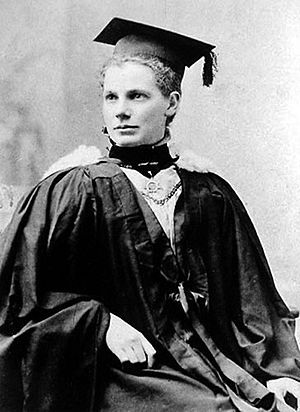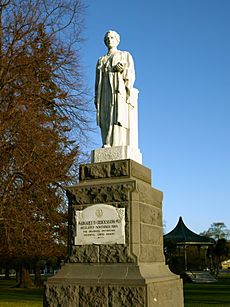Margaret Cruickshank facts for kids
Quick facts for kids
Margaret Cruickshank
|
|
|---|---|

Margaret Cruickshank, ca 1897
|
|
| Born | 1 January 1873 Palmerston, New Zealand
|
| Died | 28 November 1918 (aged 45) Waimate, New Zealand
|
| Monuments | Statue of Margaret Cruickshank in Waimate |
| Alma mater | University of Otago |
| Occupation | Medical doctor |
| Known for | First registered female doctor in New Zealand; first female doctor to work in a general practice in New Zealand |
Margaret Barnett Cruickshank (born January 1, 1873 – died November 28, 1918) was a pioneering doctor from New Zealand. She was the very first woman to officially register as a doctor in New Zealand. She sadly passed away during the 1918 influenza pandemic, a worldwide sickness. After her death, she became the first woman in New Zealand, besides Queen Victoria, to have a special monument built in her honor.
Contents
Early Life and Family History
Margaret Cruickshank was born on New Year's Day in 1873. She was a twin, and her sister's name was Christina. They were born in Palmerston, a small town in New Zealand's South Island. Their parents, Elizabeth and George, had moved from Scotland. They first lived in Australia, then moved to Dunstan in Central Otago. They went there to join the Otago Gold Rush.
When Margaret and Christina were young, their mother passed away in June 1883. This meant the twins had to help care for their five younger brothers and sisters. They took turns going to school. The twin who went to school would teach the one who stayed home. This way, they both finished their studies at Palmerston District High School.
After high school, they both went to Otago Girls' High School in Dunedin. In 1891, both girls were the top students, known as duxes. Christina later earned two advanced degrees from the University of Otago. She became the principal of Wanganui Girls' College for more than 20 years.
Becoming a Doctor in New Zealand
Margaret Cruickshank studied at the University of Otago Dunedin School of Medicine. She was the second woman in New Zealand to complete medical school. She graduated in 1897, following Emily Siedeberg, who was the first.
Margaret then started working as a general doctor in Waimate. This made her the first woman in New Zealand to work in a general medical practice. She first worked as an assistant to an experienced doctor named HC Barclay. She continued her studies and earned her MD degree in 1903. Other women who became doctors in New Zealand after her included Alice Woodward, Daisy Platts, and Jane Kinder, all in 1900.
In 1913, Dr. Cruickshank went overseas for more advanced studies. She studied in Edinburgh and Dublin. She also traveled through Europe and America. To show how much they respected her, the people of Waimate gave her a gold watch, a chain, and 100 gold coins. They presented these gifts at a public event before she left.
You can see this gold pocket watch at the Waimate Museum. Inside the watch, it says: "Presented to Margaret B Cruickshank, from her many Waimate Friends Feby. 13th 1913."
Helping During the War and Flu Pandemic
During World War I, Dr. Cruickshank helped organize the Waimate Red Cross Fund. She also took over all the patients from her partner, Dr. Barclay. He had joined the army and gone overseas. She was also one of three doctors who shared his job as hospital superintendent while he was away.
When the 1918 flu pandemic began, Dr. Cruickshank worked tirelessly. She worked day and night, caring for children whose parents were sick. She cooked meals for them and even milked cows for families who were too ill to do it themselves. Eventually, she became sick herself and passed away on November 28, 1918.
Dr. Cruickshank's Lasting Legacy
In 1923, a special memorial statue was revealed in Seddon Square in Waimate. Many people spoke at the ceremony. These included Dr. Emily Siedeberg, who was Margaret's former classmate. She represented the New Zealand Medical Women's Association. The local Member of Parliament, John Bitchener, also spoke.
The statue was carved by a New Zealand artist named William Trethewey. It was the first monument built in New Zealand for a woman other than Queen Victoria. The words on the statue say: "The Beloved Physician – Faithful Unto Death."
In 1948, the maternity ward at Waimate Hospital was named after her. This was to honor her memory.
In 2007, the New Zealand Ministry of Health named a pandemic practice exercise 'Exercise Cruickshank'. This was to remember her important work during the 1918 flu pandemic.
The Waimate Museum & Archives has many items belonging to Dr. Cruickshank. These include objects, letters, photos, and artwork. Some of these can be seen online through NZMuseums.
In 2017, Dr. Cruickshank was chosen as one of the Royal Society Te Apārangi's "150 women in 150 words". This project celebrates the important contributions of women to knowledge in New Zealand.


